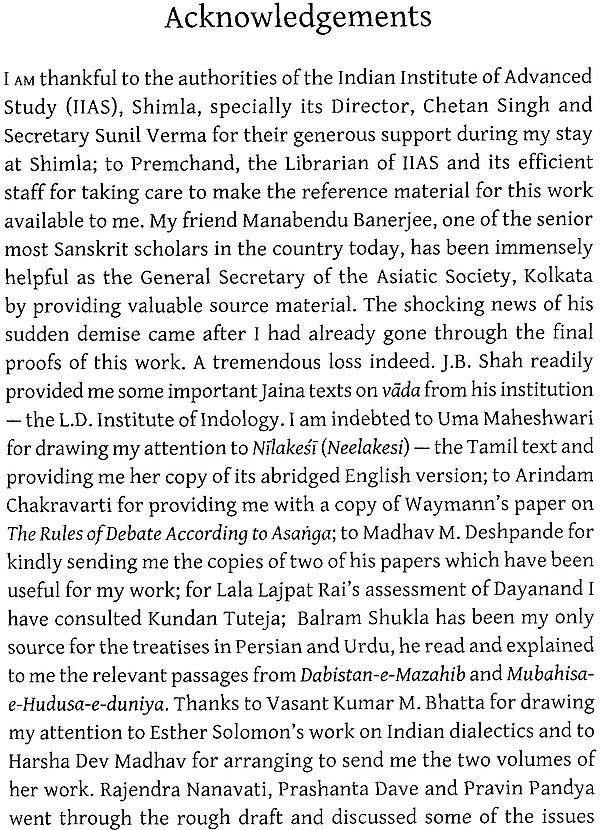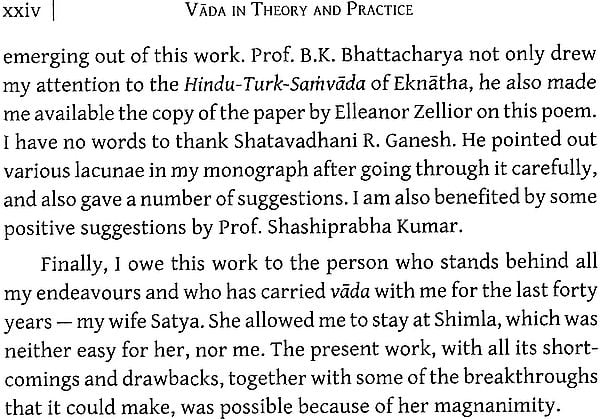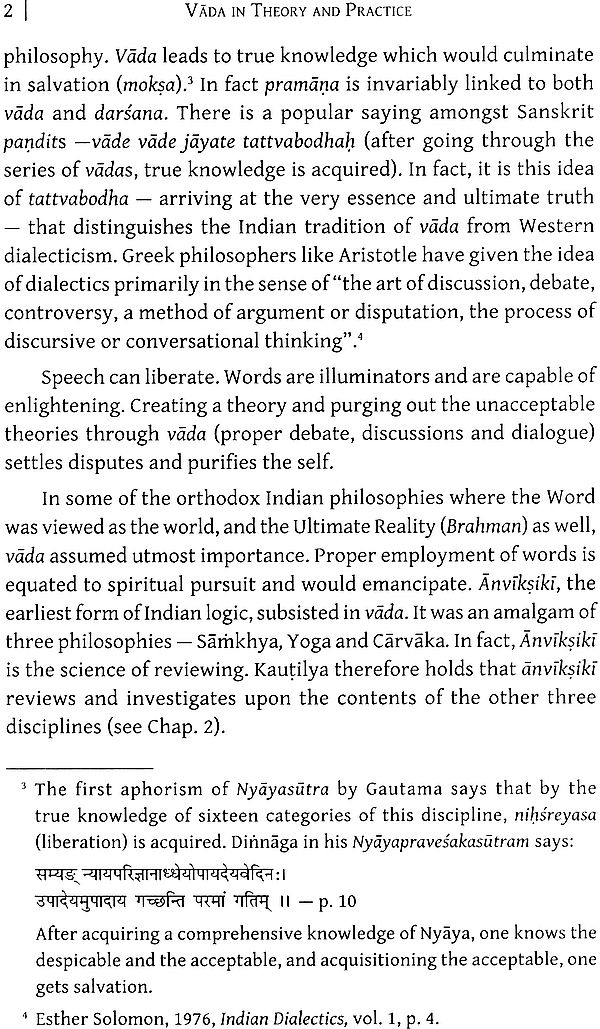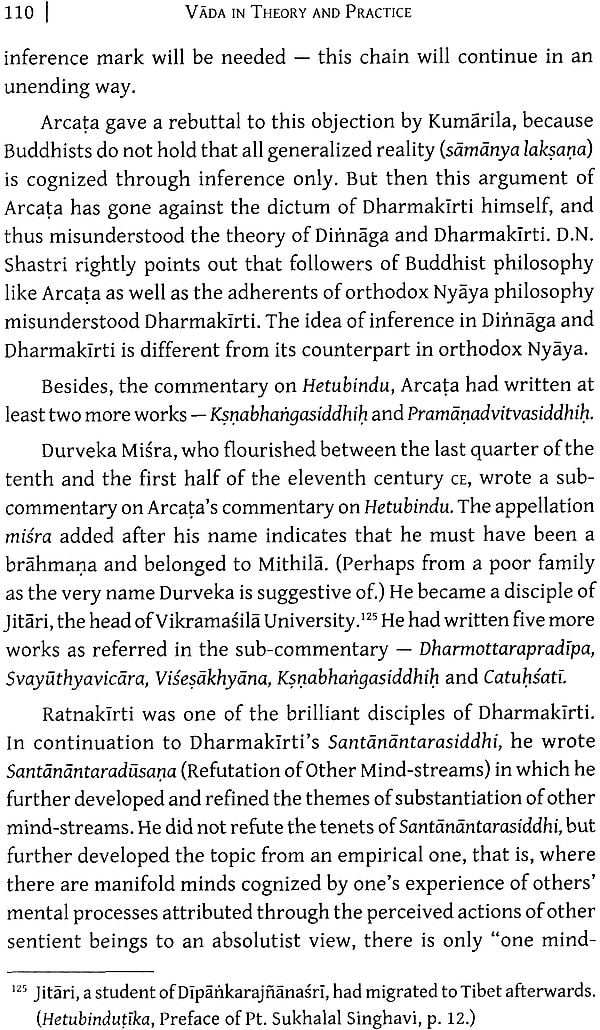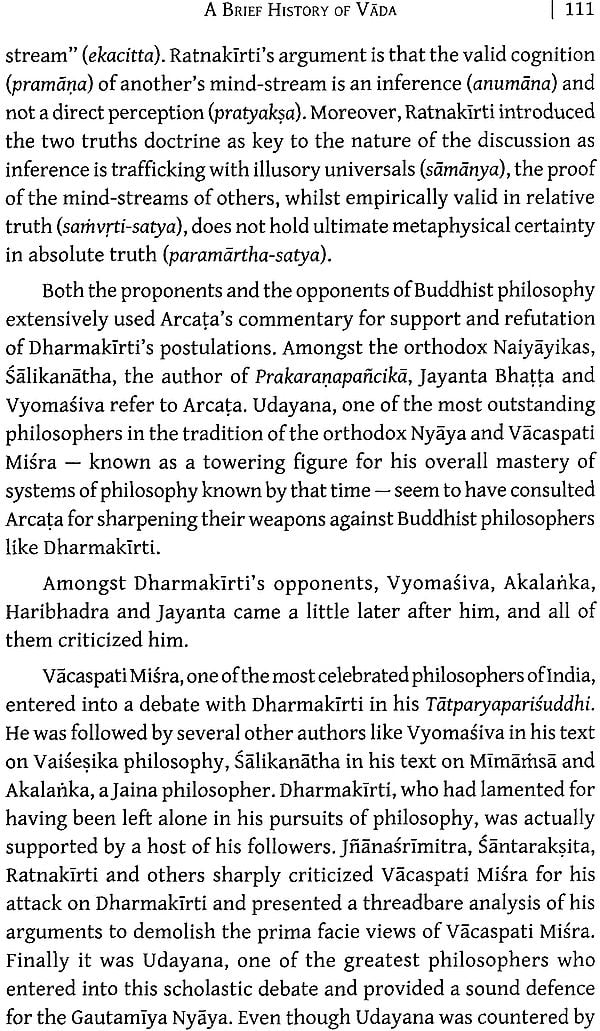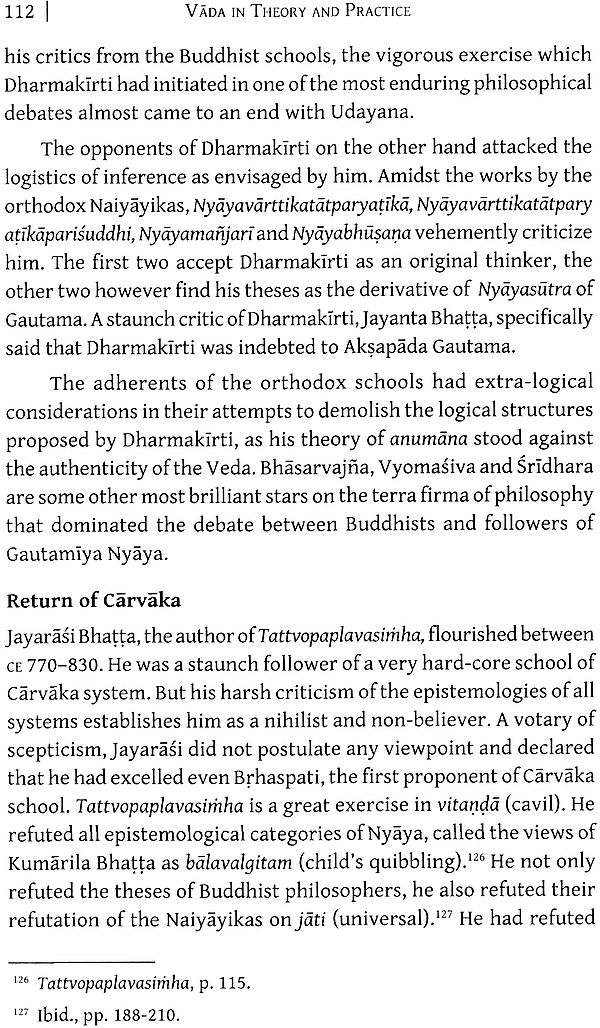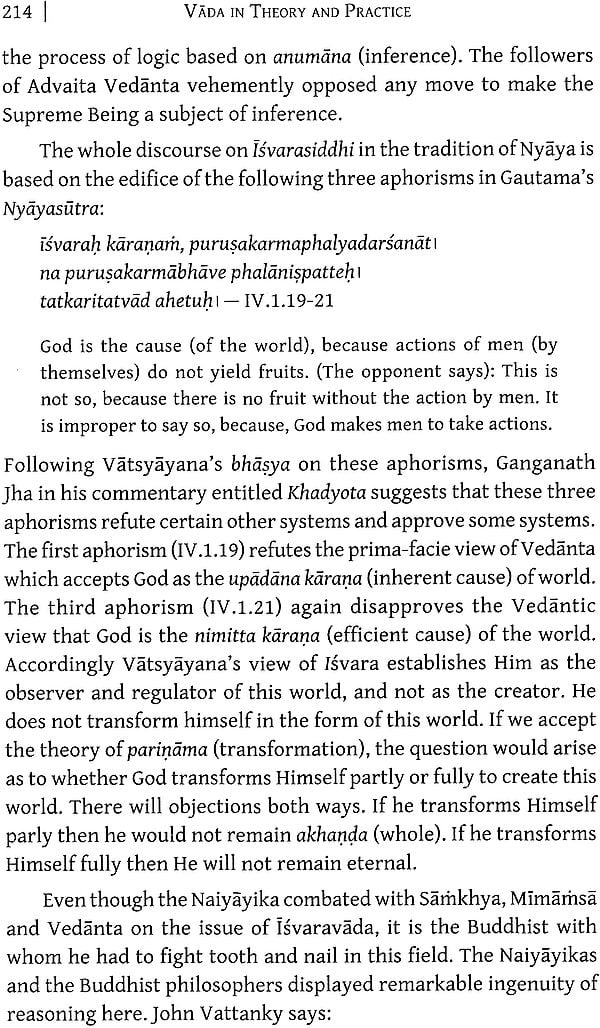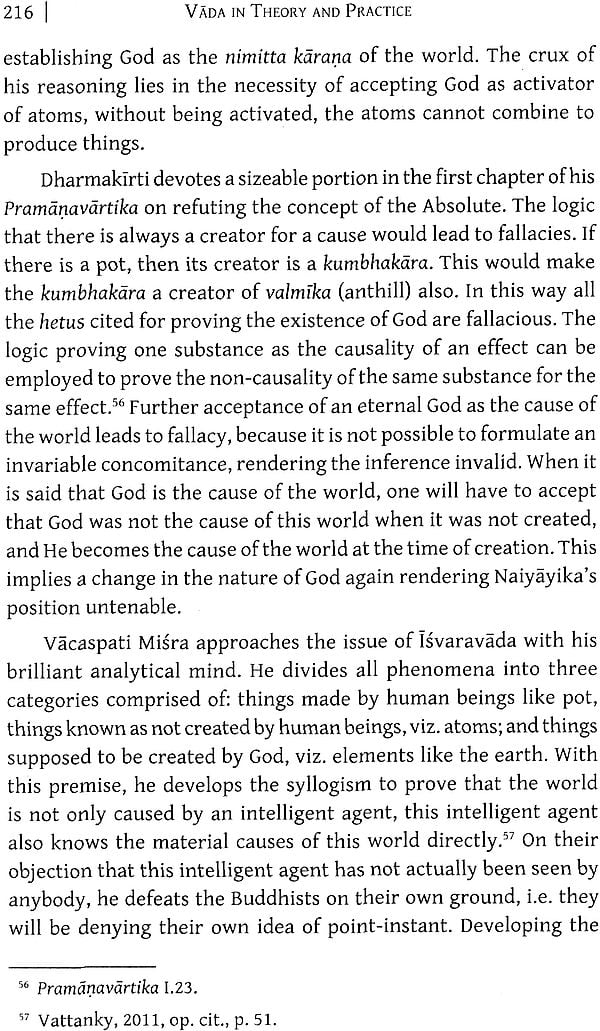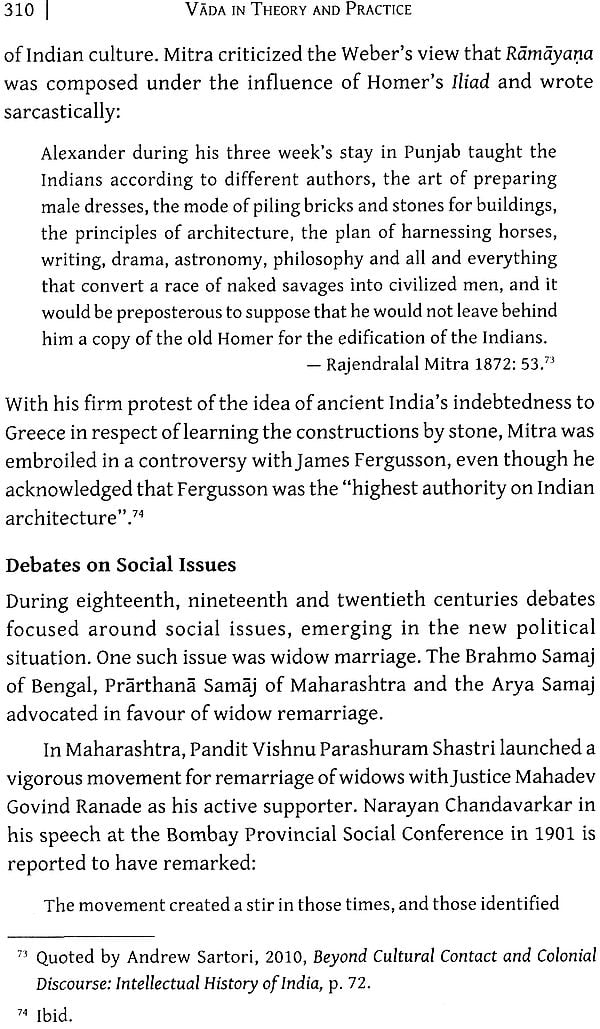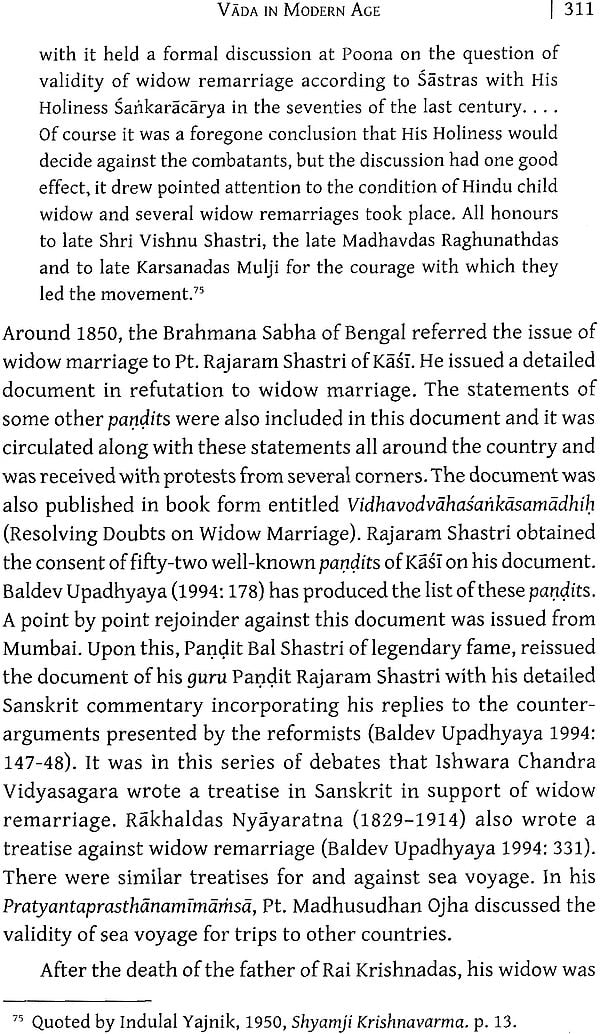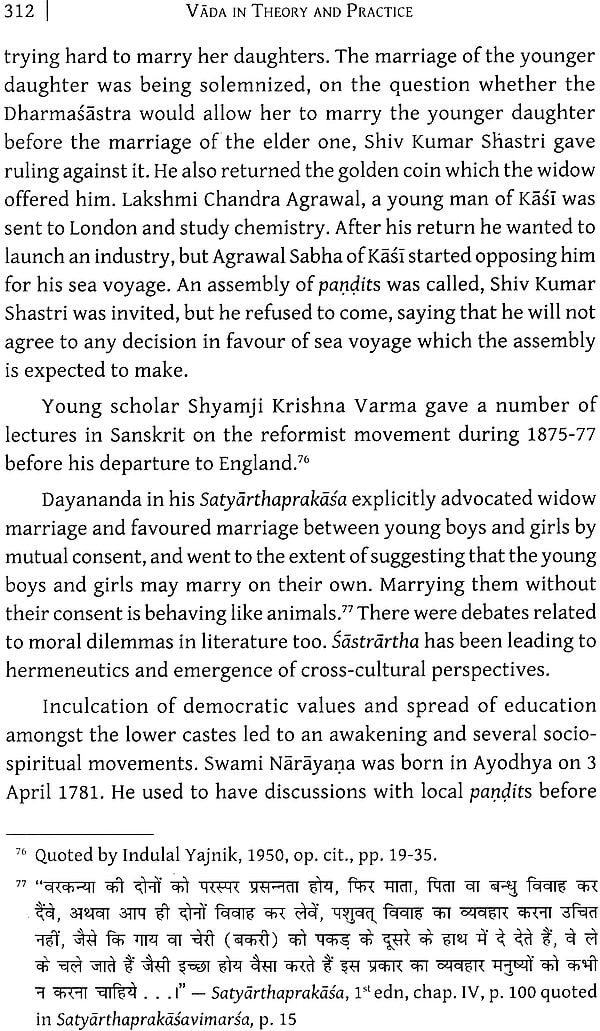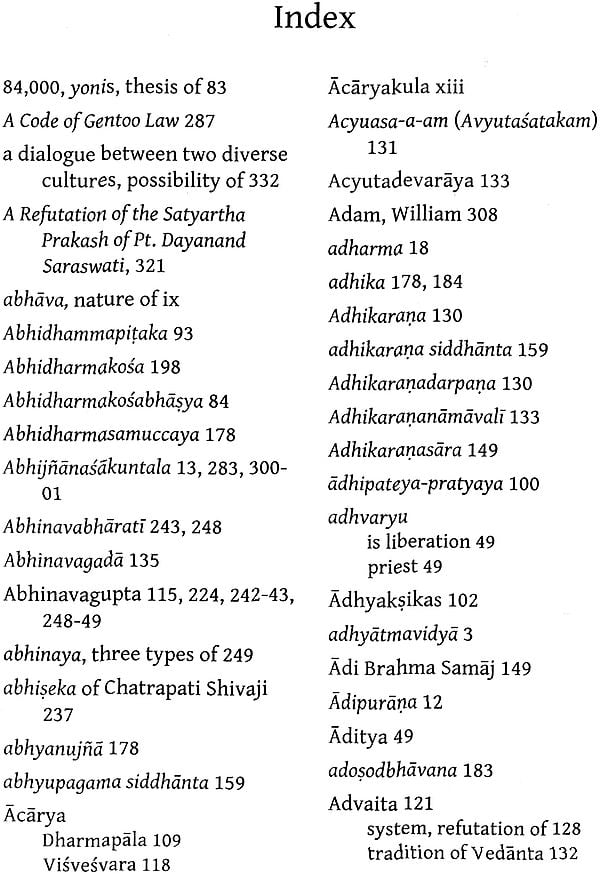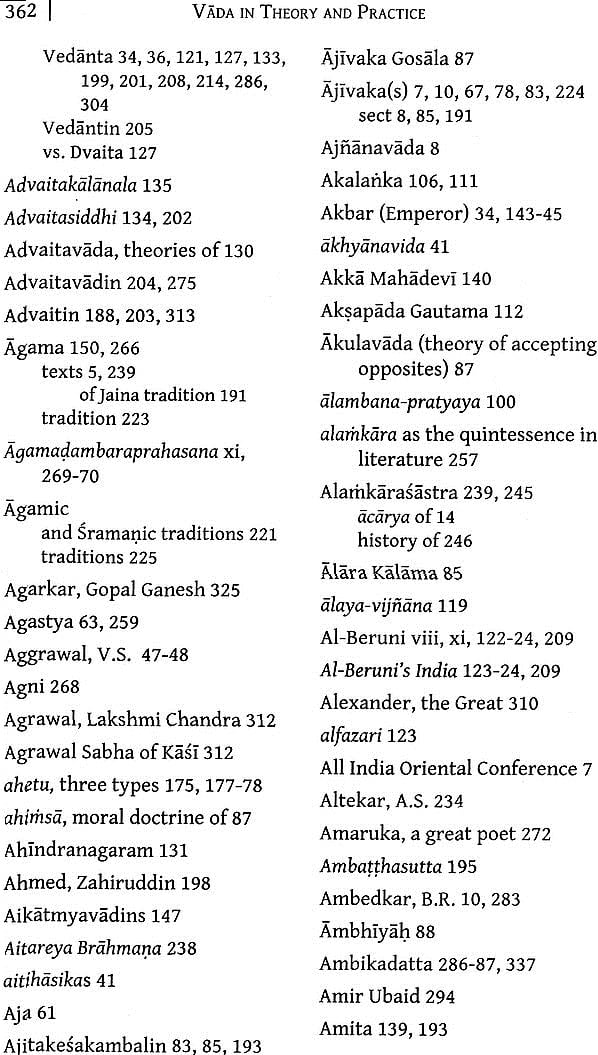
Vada in Theory and Practice (Studies in Debates, Dialogues and Discussions in Indian Intellectual Discourses)
Book Specification
| Item Code: | NAN415 |
| Author: | Radhavallabh Tripathi |
| Publisher: | D. K. Printworld Pvt. Ltd. |
| Language: | English |
| Edition: | 2016 |
| ISBN: | 9788124608562 |
| Pages: | 430 |
| Cover: | Hardcover |
| Other Details | 8.5 inch x 5.5 inch |
| Weight | 720 gm |
Book Description
Vada, meaning debates, dialogues discussions, was the quintessential of Indian spirit, enabling and promoting the growth of different philosophical and knowledge systems of India. It percolated deep into our mindset and enriched the moral, ethical, religious and sociocultural edifice of anything that was essentially Indian in nature. As continuation of Anviksiki from the BC era, uada helped thrive Indian traditional knowledge systems. It subsists on diversity and its tradition envisages pluralism.
Most of our Sanskrit works, covering a wide gamut of knowledge systems, are structured in the techniques of debate. This reality applies not only to the philosophical writings, but to Indian medical systems (Ayurveda), Arthasastra of Kautilya and kamasutra of Vatsyayana as well. Even great epics like Ramayana and Mahabharata are no exceptions.
Vada culture involved verbal duals, attacks and even violence of speech, and all major religious systems-old or modern-were parties to it. This book also elucidates how vata was vital and critical for the growth of our socio- political fabrics. it shows how some of the major conflicts in philosophical systems were centred around karma, jnana, choice between violence and non-violence, pravrtti and nivrtti. It also presents the manifestations of vada on a vast canvas during the nineteenth and twentieth centuries. Modern spiritual and religious gurus like Ramana Maharshi, J. Krishnamuriti and Vinoba Bhave were men of dialogues. Our scholars have applied the varied techniques of vada against the philosophical and scientific systems of the West to prove them correct.
This collector’s issue should enthralla a wide audience of philosophers, scholars and believers in Indian knowledge systems.
Prof. Radhavallabh Tripathi is known for his original contributions to literature as well as for his studies on Natyasastra and Sahityasastra. He has published 162 books, 227 research papers and critical essays. He has received 35 national and international awards and honours for his literary contributions.
He has been referred in various research journals on Indology. Research for PhD has been completed as well as is being carried on his creative writings in Sanskrit in a number of universities. Three journals brought out special numbers on his writings. Seven books comprising studies on his creative and critical writings by other authors have published.
This monograph is mainly the result of studies conducted by me as a Fellow at the Indian Institute of Advanced Study, Shimla; during the year 2014-15. My areas of study were sahityasastra (Literary Theory) and Natyasastra (Theory of Drama and Theatre). But as a teacher and researcher, I have always remained conscious of the vitality of vada-which is roughly translated for the purpose of this work as a category involving theory and practice of intellectual debates, dialogues and discussions. Traditional knowledge systems in India thrived because of vada. These traditional systems have been subjected to a general negligence during the last two centuries or have been largely misrepresented. There has been an overemphasis on spirituality and religion in the recent studies on the ancient Indian knowledge systems, and the disciplines having a focus with logic and arguments remained sidetracked. Anviksiki (logic and investigation) was a major discipline which was highly valued in BCE. era. K. Satchidanada Murty rightly points out that “the study of classical philosophy in India has been dominated by darsana-concept, ignoring the Anviksiki-concept of philosophy”. A revisit to the theories and practices of vada will hopefully lead to viewing these knowledge systems in their right perspective.
Vada subsists on diversity. No vada is possible if there is only one point of view. Also, vada does not happen in singularity, it always is a prerequisite to the other and mostly promotes the presence of many others. India’s history of ideas and debates presents a multilinear view. The tradition of vada envisages pluralism. The learned editors of Isibhasiyain, a neglected work, but immensely valuable for understanding the Indian vada, tell us that during the days of Mahavir there were as many as theories discussed under four well-known sects. Vada vitalized intellectual life and the seers, monks and intellectuals in the asramas, viharas and samghas.
I have used the Sanskrit term vada in a broad sense here and have given its nearest approximation-"debate" in bracket where vada is used to denote a restricted sense. The seven chapters of this book deal with various aspects of the theory and practice of vada. Since no comprehensive study in this field has so far been made (the works by Amartya Sen and A. Raghuramaraju merely touch its fringes, and the work by Esher Solomon mostly takes up the dialectic divergences) and the present study is intended to be a groundwork only, it was not possible for me to go deep into so many versatile aspects of study on vada. The use of the word "Indian" in the subtitle may be termed as a misnomer. Owing to my limitations, I have mostly used Sanskrit sources for the treatment of vada in theory and practice. But the intention was not to keep this work confined only to Sanskrit traditions of vada; I have tried to include alternate or parallel traditions. Reference to Naryosang, Al-Beruni, Dara Shikoh or the works like Dabistan-e-mazahib, how so ever insufficient and scanty they may be, do indicate a broad framework for a study like this.
I hope that this book will prove how vital and important vada-comprising theories and practices of debate, dialogue and discussion-has been, not only for the growth of our knowledge systems and ideologies, but also for our socio-political fabrics. Vada was cultivated in India's intellectual discourses to project the distinct nature and uniqueness of each concept. This was possible through the frank admittance of both the agreements and the disagreements. Samvada (correspondence) and vivada (difference) are two faces of vada. Texts like Isibhasiyain and Sastravartasamuccaya of Haribhadra Suri could be composed because of the first, whereas the second inspired a vast mass of philosophical literature. But then, there are inherent correspondences in the difference and the differences loom large when correspondences are being sought out. Gaudapada categorically said in Mandukyakarika IV.99 that he has not borrowed from Buddha, but his concept of vijnana or consciousness as the Ultimate Reality and the world appearing due to the diverse nature of vijnana together with the examples he has given to illustrate his thesis are derived from Buddhism. A little intriguing example of such correspondence is Sankaracarya himself. He vehemently criticized Buddhist philosophies, but beneath a very intense tussle and difference of outlook, there is an inherent acceptance of the Vijnanvadin for which he is also labelled as a Buddhist in disguise (pracchannabaudha), no by a section of modern scholars alone, but by some of the adherents, of classical non-dualist philosophers like Vedantadesika, an extraordinary philosopher-poet of thirteenth century and a nephew of Ramanuja. F. Stcherbatsky and Dhirendra Sharma have shown that by begging to differ with his guru Kumarila on the nature of abhava (non-existence), Prabhakara denied the status of a pramana to abhava and thus followed the path of Dharmakirti, a well-known Buddhist logician; and hence he was decried as “a friend of the Buddhists" (bauddhabandhuh).
It is true that we find a lot of manoeuvring in vadas. But this has contributed to maturing a particular system of ideas. The search for truth led the seeker to traverse on diverse paths.
Intellectual discourses in India have remained so much argumentative that most of the works written in Sanskrit under diverse knowledge systems are structured in the techniques of debate. This applies not only to philosophical writings but to works belonging to medical sciences (Ayurveda) or works related to the management of society and life like Arthasastra of Kautilya or Kamasutra of Vatsyayana. There are texts that have been thoroughly structured through vada.
Some of the issues that have repeatedly surfaced in vadas are concerned with the conflict between karma (action) and jnana (knowledge), choice between violence and non-violence, the clash between two ideologies-pravrtti (empiricism) and nivrtti (renunciation) and these still persist in modern India in some form or the other. The doctrine of cumulative pursuit of karma and jnana continued till sankara vehemently discarded it.
| Prologue | vii | |
| Acknowledgements | xxiii | |
| 1 | The Nature of Vada | 1 |
| Vada, Samvda and Vivada | 5 | |
| Vada, Protests and Dissents | 9 | |
| Reverting the Gaze | 13 | |
| Concept of Sabha | 13 | |
| Appreciating a Conversation | 16 | |
| Ethics of Debate | 17 | |
| Violence of Speech | 20 | |
| Sandhi: Agreement with Disagreements | 23 | |
| Language and stylistics | 23 | |
| The Ego, Prides and Prejudices | 28 | |
| Types of Debates, Dialogues and Discussions | 29 | |
| Vada as a Digvijaya | 31 | |
| Vada Internalized | 32 | |
| Vada in Texts | 33 | |
| Texts on the Theory of Vada | 34 | |
| Manuals on Vada | 36 | |
| Documenting Vadas | 37 | |
| History of Vada | 38 | |
| Genres | 38 | |
| 2.A | A Brief History of Vada | 40 |
| I | Mantra-Kala (The Age of Revelation) | 42 |
| Upanisadic Debates | 47 | |
| Debates, Dialogues and Discussions in Ramayana | 55 | |
| Debates in Mahabharata | 66 | |
| Nirukta as a Documentation of Debates | 77 | |
| II | Tarka-Kala (The Age of Arguments) | 78 |
| The Continunance of Anviksiki | 83 | |
| Buddha's Dialectical Method of Discourse | 83 | |
| Mahavira and the Tradition of Debate | 86 | |
| Arthasastra as a Text of Debates | 88 | |
| other Knowledge Texts | 90 | |
| Buddhist Councils, Debates and Split | 90 | |
| Kundalakesi: The Lady Debater | 94 | |
| Milindapanho | 94 | |
| Asvaghosa: His Debates with Buddhists and Non-Buddhists | 96 | |
| Debates within Buddhist Schools | 97 | |
| Debates between Buddhist Logicians Naiyayikas | 98 | |
| Debates within Orthodox Systems of Philososphy | 101 | |
| Debates between Buddhists and ?Naiyayikas | 107 | |
| Vadas after Dharmakirti | 109 | |
| Return of Carvaka | 112 | |
| Debates on Philosophy of Language | 114 | |
| Sankara's Conquests | 115 | |
| Udayana | 118 | |
| III | Vistara-kala (The Age of Diversification) | 121 |
| Challenges to Sankara's Advaitavada | 126 | |
| Vadiraja | 132 | |
| Creating Bridge through Vada | 138 | |
| The Reconciliation | 146 | |
| 3 | Vadasastra: The Theories of Debate, Dialogues and Discussions | 152 |
| Theory of Vada in Mahabharata | 152 | |
| Vada and Nayadarsana | 156 | |
| Caraka on the Theory of Vada | 166 | |
| Asanga on the Types of Vada | 178 | |
| Debate on the Debate: Buddhist Critique of /Naiyayika | 180 | |
| Codes for Conducting the Debate | 184 | |
| 4 | Vada in Darsana: Philososphical Debates | 188 |
| Tussle between Action, Knowledge and Devotion | 188 | |
| Revisionism | 189 | |
| Debates between Idealism and Materialism | 190 | |
| Critique of Carvaka Philosophies | 195 | |
| Debates on the Nature of Reality | 196 | |
| Debates on Scriptural Authority | 208 | |
| Debates on the Theory of Knowledge | 209 | |
| Debates on the Theory of Causality | 212 | |
| Debates on the Absolute and God as Creator | 213 | |
| Debates on the Concept of Moksa | 219 | |
| 5 | Vada in Dharma: Socio-Political and Legal Debates | 221 |
| Debates on Polity and Governance | 225 | |
| Vajrasuci and the Debate on the Caste System | 226 | |
| Debates in Dharmasastras | 227 | |
| Debates on Rights of Women | 229 | |
| Openness for Debate | 236 | |
| 6 | Vada in Literary Theory and Literature | 239 |
| Natyasastra as a samvada Text | 239 | |
| Vada Reflected in the Conceptual Framework of Natyasastra | 241 | |
| Concepts and Categories of Vada in Literary Theory | 245 | |
| Major Debates in Literary Theory | 246 | |
| Kavyamimamsa as a Vada Text | 247 | |
| Rasa Discourse: Debates and Diversities | 248 | |
| Debates on the Theory of Alamkara | 256 | |
| Natankusa: A Vada with the Cakyars | 257 | |
| Vadas in Kavya Literature | 259 | |
| Kalidasa's Kavyas as Debates | 259 | |
| Bhavabhuti's Plays as Vada Texts | 262 | |
| Brhattrayi: As a Vada Discourse | 266 | |
| Dhuttakkhana (Dhurtakhyana): Debates by Rogues | 269 | |
| Agamadambaraprahasana of Jayanta Bhatta | 269 | |
| Vada in Kavya and Kavya in Vada | 271 | |
| 7 | Vada in Modern Age | 282 |
| Debates on India's Identity: Relocating Her Global Image | 284 | |
| The Role of the Pandit: Vada Reformulated | 286 | |
| The Shift in the Debates | 291 | |
| Orientalism | 295 | |
| Romantic Shifts in the Debate | 300 | |
| Theological and Religious Debates | 303 | |
| The Debates by Roy | 305 | |
| The Vilification and Its Aftermath | 307 | |
| Debates on Social Issues | 310 | |
| Debates of Arya Samaj | 314 | |
| Satyarthaprakasa: A Text on Debate | 314 | |
| Refutations of Satyarthaprakasa and Rejoinders | 319 | |
| Dayananda's Debates on Public Platforms | 321 | |
| Ramabai | 324 | |
| The Sastrartha Continues | 326 | |
| Paramarthadarsanam | 327 | |
| Creating Hermeneutics | 329 | |
| The Dialogue Renewed | 331 | |
| Epilogue | 336 | |
| Appendex: Selected List of Vada Referred in This Work | 338 | |
| Bibliography | 345 | |
| Index | 361 | |
